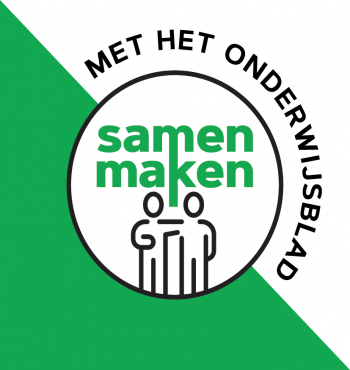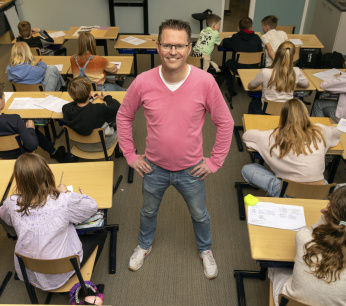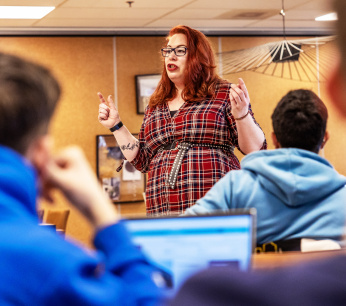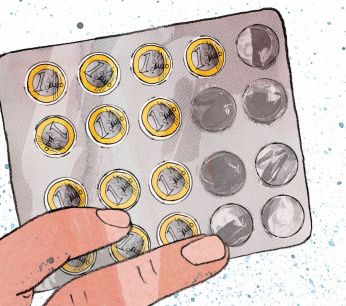Give the teacher space and trust
Sufficient freedom is essential for job satisfaction. While the outside world often thinks that the teacher is king in the classroom, practice in many places shows otherwise. 'Education has become a straightjacket.'
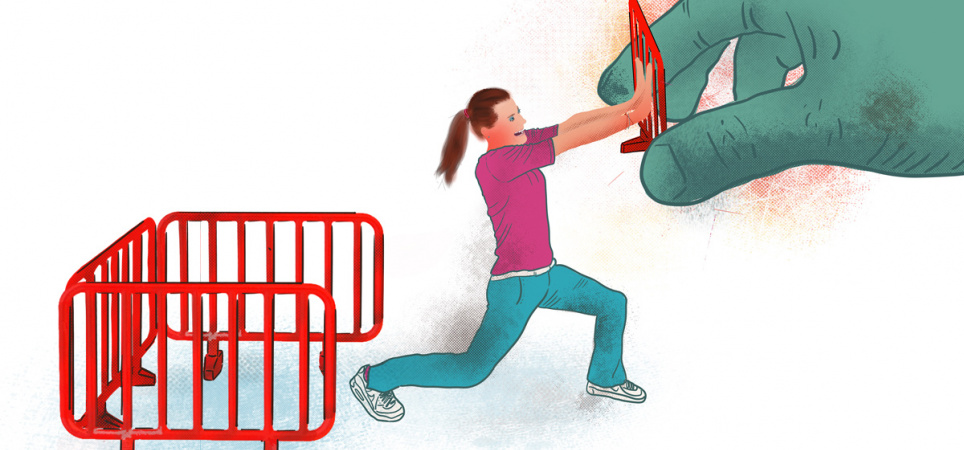
Picture: Type tank
Compressive schedules, coercive instruction models and micro-managing managers. Anyone who reads most of the responses to the question 'How much freedom do you experience in your work?' will not be happy. Of the almost seven hundred people, mainly teachers, who completed the questionnaire, roughly two-thirds indicated that they experienced insufficient autonomy.
Also check out the news from this study: 'Pressure on numbers leads to fraud'
It is unclear whether this number is representative of the profession. Perhaps a person is more inclined to answer questions about autonomy when he experiences problems in that area. However, the same elements often recur that limit autonomy:
- Too much administration, especially for 'the inspection' or for 'Cito'
- Following imposed methods and instructional models, without participation
- Working as uniformly as possible under strict schedules, with hardly any breaks
- Mandatory to undergo an educational reform
- Compulsory to attend irrelevant study days, without participation
- Many outside experts determine the teacher's work
- Giving the opinion of parents and students more weight than the professional opinion of the teacher
Teaching methods are so rigid and rigid that you can no longer put your own spin on them.
There are also common denominators among the group of people who experience sufficient professional freedom (37 percent) or whose autonomy has even increased (22 percent). What is particularly striking here is: gaining space and confidence, being able to complete your lessons yourself, determining your daily schedule or developing tests (test and closing program). A higher professional education lecturer writes: “I can devise the working methods for my lectures myself. And, as long as the knowledge base is guaranteed, so does the content of the lectures. I see that as freedom.”
Together we achieve more! Join the AOb
Autonomy - according Van Dale means self-government or: independence of the human will, free will - is, according to researcher Tanja Traag, on 'the right side of the seesaw'. This spring Her employer, the Central Bureau of Statistics, concluded on the basis of data from the national National Working Conditions Survey that employees who experience little autonomy and at the same time a high workload suffer from 'work-related psychological fatigue complaints' much more often than other employees. Education is one of the sectors where this often occurs.
Education has become a straightjacket. So much has to be recorded, tested and registered that this is at the expense of preparation time and therefore of creative and inspiring teaching.
Traag: “When it comes to work stress, you actually have to imagine a seesaw. On the one hand, the demands placed on you, the time pressure under which you have to do your work, and how emotionally taxing it is. And on the other side of that seesaw is support from managers and colleagues and, above all, autonomy.”
The difficult thing in education is that some of those freedom aspects are not there at all, or are less so. School times are fixed. What a student must learn is determined by others. And taking leave outside the school holidays is virtually impossible. Traag: “If I have had a tough time at work, I can create breathing space. Take a day off or take on tasks that are less stressful. Education staff generally do not have that freedom of choice.”
This makes it extra important that there is sufficient freedom in practicing your profession. Upon request, Wiljan Hendrikx of the Dutch School for Public Administration views a summary of the results of the Education magazine-poll. From 2013 to 2019, he conducted research into 'professional identity in relation to policy reforms' in secondary education and recognizes a lot in the responses. According to Hendrikx, the problem partly lies in the number of parties that "have views on what is important and how things should be done, both substantively and in terms of didactics and pedagogy."
There is far too many people in management who believe they understand education. I feel like doing work for this layer.
Moreover, all those parties, such as political parties, but also all kinds of commercial agencies, cannot hold back and leave education to the professionals. “Views also come from society,” says Hendrikx. “Teachers are really at the focal point of this. Every social 'problem' must ultimately be solved in education. That is of course crazy. And it is difficult in practice. Also because 'solutions' are sought in measurable performance indicators.”
The Education magazine asked via social channels and newsletters from the AOb: How much freedom do you experience in your work? Nearly 700 people completed the survey. The majority of them, 586 people, are teachers. 86 people work in a support position (such as IT staff, janitors, administrative staff or managers) and 13 people are retired. Of the people who reported their sector, 244 work in primary education, 250 in secondary education, 93 in secondary vocational education, 54 in special education, 34 in higher professional education and 1 in university education.
Margriet van der Sluis works as a researcher for TIAS, where, among other things, school leaders are trained. She also scanned the results and read “a lot of dissatisfaction, teachers who are not included in all kinds of decisions”. But, she says: “Teachers don't always want freedom either. You also need frameworks. It is not: the more autonomy, the better.”
This year I have never had so many class visits. They come with more and more and observe absolutely everything.
Van der Sluis recognizes that 'people from outside' increasingly observe classrooms and find something to say about what a teacher does. But she thinks that's smart: “Being lord and master in your own classroom is no longer possible. The problem has become too big and too complex for that.”
However, Van der Sluis believes that the school management must form a buffer between teaching staff and what is asked of them. And she notes that teachers in the Netherlands have a different position than, for example, their colleagues in Denmark. “There the teacher predominates in the debate about education.”
Hendrikx also believes that the Netherlands lacks 'a strong professional group'. “Actually, there isn't really a group. The comments of the respondents are: a lot is prescribed and control is enormously at stake. Apparently it is not possible to really take action against this.”
I definitely have to follow a certain approach and methodology. Thinking independently and arguing is not an option
This is different in other professional groups, Hendrikx notes. “GPs, for example, have developed their own professional standards. If you want to provide more counterbalance, you will have to organize yourself better as a group and also create a more common framework about what good education is.”
Both scientists realize that the staff shortage is probably a major problem here. “It's continuous running with too few people and catching gaps,” says Hendrikx. “The time for reflection and work on the profession is limited or it is done by outsiders. While that space will really have to be enforced.”
My time is constantly taken up with pointless training, workshops and meetings
AOb-director Thijs Roovers states that it was also not possible to form a professional group when the economy was still booming, with sufficient staff. “Think of the Teachers' Cooperative, or what I have tried myself, the Teachers' Collective. Uniting people based on content is simply very difficult. It's not in our DNA. The focus is the classroom, the students and your own lessons.”
But how does autonomy end up in the DNA? According to Roovers, on the one hand through teacher training. “What your profession entails, control over it, what autonomy means and how you maintain it: attention should be paid to these topics during your training.” The trade union also plays a major role. "The AOb is the largest association of teachers in the Netherlands. We need to gather more information about what is going on through surveys and meetings. And going into schools: helping to draw up a professional statute, for example. Determine the professional image together.”
That sounds far from current reality. "Maybe. But we are certainly working on it Professional image (a project by teachers to arrive at a widely supported standard, ed.), with polls, with AObconsultants who visit schools. Even if something doesn't work twice, you should try it a third time. It's too important. Because it is also about the workload and health of many people.”
The mantra of the school management is that professional space may be limited if it conflicts with the school's course. And everything falls under the school's policy.
Roovers refers to the 2018 workload agreement. “With the money we have received since then for workload, we have succeeded.” The AOb then facilitated with handouts. The discussions took place in the teams at the schools: what do we need in our situation to reduce the workload? Roovers: “If all goes well, that topic will come up again and again: are we still spending that money on the right thing? This way you achieve your autonomy together, every year.”
Professional image on tour
Are you coming together with at least 25 fellow teachers in October or November? For example for a study or school day, a meeting of sections or a cross-school event? The AOb is happy to provide a free two-hour workshop! Seize your opportunity to help build the Professional Image of Teacher. read more
